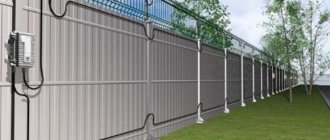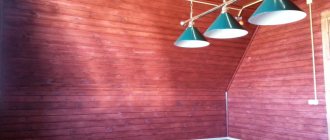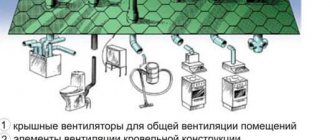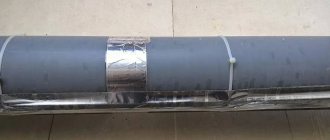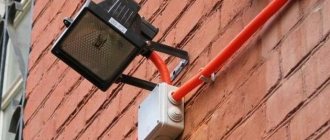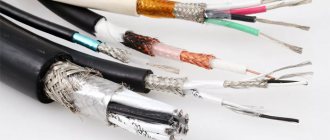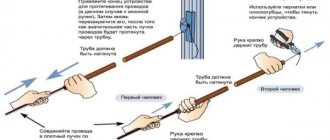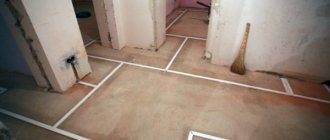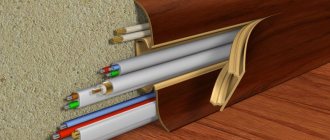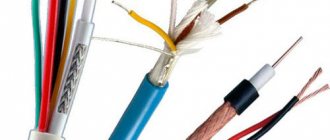Installation of a cable line on the street is divided into overhead lines and underground installation. If with overhead lines everything is clear - cables are laid on supports or in cable galleries on trays, then with an underground line everything is a little more complicated. Especially if you have to do it under the road. The difference is that the conductor is affected not only by the weight of the soil, but also by the passing traffic flow. Let's look at the general rules of underground installation, and then we'll figure out how to lay cables along the road.
Requirements for cables laid underground
Listing all the requirements for underground electrical wiring is long and simply pointless. Therefore, most of them will be considered next, which really concerns the laying of power cables in trenches.
- The depth at which the cable must run underground. If someone thinks that they can simply sprinkle the electrical wire with earth and this will be enough to prevent it from being damaged by a shovel during any excavation work, then this is not so. In reality, the depth to which the wire should be immersed in the ground depends on the freezing of the soil and the proximity of groundwater, which often causes irreparable damage to the power lines in the trench. The PUE clearly states that the cable must be buried at least 75 cm in the ground, but it is important to take into account that this applies to low-power power systems.
- High protection of underground electrical wiring from mechanical damage. To do this, the cable is inserted into a special pipe or corrugated hose. You should not think that this is reinsurance; such safety measures allow you to avoid damage to wires by ice in the winter season and when the ground moves. In addition, according to experts, a cable laid in a pipe is easier to replace if the latter fails. But in this situation, it all depends on how long the power system lay underground, since very often the pipe can collapse over time.
- Adding sand to the trench is also a fairly important factor, providing additional protection for underground cables from mechanical damage. Thanks to the sand cushion, the wire will not come into contact with solid soil particles. In this case, the backfill is carried out in several stages: to the bottom of the trench and on top of the laid wires. Thus, the electric cable turns out to be between two sand layers. It is very important that the bedding, like the backfill, is compacted well.
- Installation of a signal tape, which acts as a kind of beacon warning that there are electrical cables underground. The tape is laid over the cable in the trench at a distance of approximately 25 cm above the power network. This is due to the fact that the bayonet of the shovel will not reach such a depth. In the case of high-voltage underground electrical wiring, bricks or concrete slabs laid on top of the wires are used as a beacon.
It is important that underground cables are not too stretched - do not skimp on wire footage. This is necessary so that when the ground moves, the electrical network does not break. According to the technology of underground cable laying, it is provided to leave a reserve, which is achieved by laying cables in small waves.
This concerns the most significant requirements in accordance with which electrical lines are laid underground. In addition to the above-mentioned PUE standards, there are also other requirements that can be found very often.
- Laying wires under roads - they must be made in a thick-walled metal pipe. This is due to increased pressure on the ground from cars and trucks passing along the road, which can cause soil movement. And, as you know, this can lead to breakage of electrical wires.
- Cables laid parallel to each other. In such a situation, everything will depend on the power characteristics of the electrical network. But in general, it is important to realize that several wires cannot be inserted into one pipe, since if one cable breaks down, the adjacent wire may also be damaged. According to the standards, each wire must be placed in an armored sleeve and located no closer than 15 cm from the adjacent cable.
Also, backfilling of cables in the ground cannot be carried out without inspection. It is imperative to ensure the integrity of the wiring and only then finally fill the trench with earth. In this case, a visual inspection is not enough; it is better to ring the wires using instruments. In addition, the protection of underground electrical wiring plays an important role, which will be discussed in more detail.
2.5.257
When crossing highways of categories IA and IB, overhead line supports limiting the span of the intersection must be of the anchor type of normal design.
On overhead lines with suspended insulators and unsplit wire in phase with a cross-sectional area of the aluminum part of 120 mm or more, the tension garlands of insulators for the wire must be double-circuit with separate fastening of each circuit to the support.
Tension multi-circuit garlands of split-phase insulators, consisting of two to five circuits, should be provided with separate fastening of each circuit to the support.
In the span of the intersection of roads of categories IA and IB, limited by anchor supports, it is allowed to install intermediate supports outside the culvert at the base of the roadway, taking into account the requirements of 2.5.262. Fastening of wires on these supports should be carried out by supporting double-circuit garlands of insulators with blind clamps.
When crossing motor roads of categories II-V, IC - III-C, the supports limiting the span of the intersection can be of an anchor type of lightweight construction or intermediate.
On intermediate supports with supporting garlands of insulators, the wires should be suspended in blind clamps; on supports with pin insulators, double fastening of wires on the overhead line and reinforced fastening on the overhead line should be used.
When constructing new highways of all categories and passing them under existing 500-750 kV overhead lines, reconstruction of overhead lines is not required if the shortest distances are maintained in accordance with Table 2.5.35.
Table 2.5.35 Shortest distances when crossing and approaching overhead lines with highways
Which cable can I use?
You cannot use the usual variants of cable products used in electrical wiring, such as AVVG, VVG, PUNP, PUGNP and others. They collapse in the ground if they are not laid in pipes. The insulation of these conductors is not intended to protect the conductors from destructive mechanical and chemical influences. To lay cables under the road, you need to use protected products, such as:
- AABl, AAB2l;
- AAShv, AAShp;
- ASB;
- AAPl, AAP2l;
- ASpl;
- AVBbShv, AVBbShp, APvBbShv.
For regions where there are severe frosts (far north), PvKShp is used.
Where is the puncture method used?
In any situations where damage may be caused to the environment, buildings and structures at the work site, vehicle traffic, etc., as well as in cases where the use of the open method is prohibited or simply impossible to implement, then it is advisable to lay pipelines using the trenchless puncture method. However, it can be used if the pipeline string or one pipe intended for installation has a diameter of no more than eight meters.
HDD is a dangerous method, therefore a number of requirements are established for the accuracy of calculations and drilling, safety precautions, studying the characteristics of soils and preventing their settlement. Work can begin only after there is a permit from the Russian Railways administration, which is responsible for a specific section of the tracks.
Requirements for PUE protection
Protection of electrical lines is considered the most important condition for laying wires in a trench underground. At the same time, according to the PUE, a whole list of requirements is imposed on underground electrical wiring.
- At the point where the electric line enters the house, the cable is placed in an asbestos-cement coupling, which protrudes at least 60 cm on each side of the wall.
- Throughout the entire duration of underground electrical wiring, the cables are protected by bricks laid across the wires or an asbestos-cement pipe. This is necessary to protect the electrical network from soil subsidence.
- When laying several wires in one trench, the distance between adjacent cables should not be less than 10 cm for a 10 kV network, 25 cm if it is a 20-35 kV high-voltage network and 50 cm between wires of different organizations.
- Wires laid in a trench must be covered with a layer of soil and laid with mechanical protection or warning tape.
- The signal tape must not be laid directly on the cable. From the wire to the beacon there must be at least 25 cm vertically. If several wires are laid in a trench, the tapes are laid separately above each cable.
- If the cable line crosses other communication systems, the warning tape should be laid no closer than 200 cm from adjacent communications.
We are developing the route
The route for underground cable laying from the pole to the house will be drawn for you in the project and all that remains for you is to follow all the instructions. But when distributing electricity along the site, you have to design the route yourself. The most economical option is a straight line from one point to another. But a real route like this practically never happens. Most often this is a broken line, since you have to go around many obstacles. Laying cables in a trench
Basic rules and technology
First you need to develop a cable route. It is clear that when laying in a straight line, less of it will be required. But, unfortunately, this is not always possible. When laying a route, it is advisable to avoid:
- Walking near large trees. It is advisable to lay the route at a distance of at least a meter from large trees. If the tree is located directly on the road, it is advisable to go around it along an arc or a trajectory close to it. In principle, the optimal distance is 1.5 m. If such an arc does not fit into the site, you can dig small trenches on both sides of the tree, drive a metal pipe into the ground between them, and pull the cable into it.
If there are more plants, they must be bypassed - It is highly advisable to bypass areas with increased traffic: parking areas, access areas for sewage disposal vehicles, pedestrian paths, etc. Such zones can be bypassed along the perimeter.
- If areas with increased load cannot be bypassed, cases are used to improve protection. Cases are also needed at intersections with drainage trays, at intersections of water supply lines, gas pipelines and other communications. If there are sections of the route with a ditch depth of less than 50 cm or in places where it was not possible to remove solid objects (old foundation, large stones, etc.), it is worth laying a protective cover everywhere.
- If the route of underground cable laying runs along the foundation, it must be at a distance of at least 60 cm from it. Laying the cable in the ground closer to the foundation is prohibited - movements of the soil or building can damage the power line.
- It is advisable to avoid crossing with other cables. If it is impossible to bypass the intersection, both cables must be in a case. They must protrude beyond the intersection by at least 1 meter in both directions, and the cables must be at a distance of at least 15 cm one above the other.
If you couldn’t avoid all the difficult places, don’t worry. In these areas, you can lay the cable not in the ground, but in a corrugated pipe, HDPE pipe or metal pipe. They are called cases. When using several pieces of metal pipes in a row, they must be welded. This is done so that they do not damage the shell at the junction points.
The procedure and technology for laying cables in the ground
They dig a trench along the intended route. Its depth is 70-80 cm, the width when laying one cable is 20-30 cm, when laying two or more, the distance between the threads laid at the bottom of the trench must be at least 10 cm. Use these criteria to decide. After the trench has been dug, you must:
- Remove all hard and sharp objects, roots, stones, etc. They can damage the insulation and may cause the line to fail.
- Level the bottom and compact it a little. It is not necessary to bring it to level, but there should not be any sudden changes.
- Pour a 10 cm layer of sand and level it. You can use cheap sand from a quarry, but it must be sifted to prevent foreign objects from getting in - stones, pieces of glass, etc. Compact the sand too. You can just crush it with your feet. There should be no obvious humps or depressions.
- Check the integrity of the insulation, if there is damage somewhere, repair it. Cases (pieces of pipes) are first put on the cable and dragged to places of increased load.
- Next, the actual laying of the cable in the ground begins - it is laid in a trench with sand. You can’t pull it - it should lie in light waves. Cases are placed in the right places along the route.
The waves will allow the line not to break during frost heaving or other soil movements - It is advisable to check the laid cable - damage may occur during installation. If you have a megometer, great, use it to check the integrity of the shell. If there is no such device, you can ring the wires for a break with a conventional multimeter or tester. It is also necessary to check them for ground. If it “grounds” somewhere, the insulation has been damaged. It is necessary to look for damage and repair it.
- If all the parameters are normal, sketch out a plan for the route, preferably to scale, with reference to landmarks. Set the distances from reliable objects to the route (from the corner of the house, the edge of the plot, etc.). Laying the cable in the ground is also inconvenient because if repairs are necessary, it is difficult to gain access. If you have a plan with dimensions, everything will be much easier.
- After this, fill the laid cable with sand. It is also sifted and a layer is poured - about 10 cm, compacted. There is no need to tamp down too much; you can compact it with your feet.
- Next, a layer of 15-20 cm of previously excavated soil is poured. When backfilling, remove stones and other foreign objects. The layer is also leveled and compacted.
- Lay down warning tape. This is a bright polymer tape with the inscription “be careful with the cable!” During excavation work, it can save underground electrical wiring from damage.
The warning tape will warn of possible excavation work - Afterwards, they continue to fill the ditch with soil, pouring it slightly above ground level, since after some time the rock will compact and settle.
Don't miss: Grounding the PUE cable armor.
Inserting an armored cable into a house is a task for professionals. And the last stage is checking the electrical parameters before connecting to the load. This completes the laying of the cable in the ground. Once again, the entire procedure can be seen in the video.
How to lay a route
When planning a route, you must adhere to the following rules:
- Avoid crossing with other cables. If this is not possible, the distance between the cables must be at least 15 cm (one is higher than the other). At the intersection, hard cases are put on both conductors - made of plastic water pipes or asbestos-cement pipes. You can put an asbestos pipe sawn lengthwise onto the previously laid cable, then connect it with ties or tape. Please note that the cases should protrude 1 meter on both sides of the intersection.
- When crossing water, sewer, or gas pipes, the distance to the cable must be at least 0.5 m if it is laid without a protective sheath, and 0.25 m if it is laid in a pipe or sheath. Moreover, the protective shell should extend 2 meters in both directions from the intersection.
- If laying cables in the ground is needed along pipelines (water, sewerage, gas), the distance to them must be at least 1 meter. When laying in pipes, the distance can be reduced to 25 cm. Large plants must be bypassed: trees and even shrubs
- If the underground power supply route runs along the heating main, the distance between them must be at least 2 meters. Moreover, the heating main must be well insulated.
- It is worth walking around the perimeter of the parking areas and the entry points for cars (including sewage trucks). If you can’t get around them, you need to either lay the route deeper or use a hard case.
- Large trees should be walked around in a large circle with a radius of at least 2 meters or a route should be laid so that the trunk is 2 meters away. There is another option - at the required depth under the tree, drive a pipe at least 2 meters long through which to pass the cable.
- There must be at least 0.75 m from the place where the conductor is laid to the bushes.
- If the cable is laid in the ground along the foundation, the distance to it must be at least 60 cm. If all these recommendations are followed, the route will not look like a straight line. You mark it on the site (with pegs, chalk, a stream of sand), check once again for compliance with the requirements, after which you can dig a trench.
Nuances and features
Laying cables in the ground is a labor-intensive process. It takes a lot to dig a trench, and then carrying the cable is also not easy. Burying is a little easier, but also not the most pleasant experience. If after a couple of years the insulation becomes leaky, you will have to repeat everything again, which will not make anyone happy. It’s clear that it’s better to do everything once and more reliably. The fact is that you can lay the cable in a trench without a protective sheath. This will not contradict the norm. And if you install a high-quality armored cable, it will last a long time.
For greater reliability, it is advisable to lay the cable in double-walled special corrugation or asbestos-cement pipes
But if you are laying a regular VVG or NYM, for greater reliability, it is better to lay it in a double-walled corrugated hose DKS along its entire length. In the right places, you additionally put on cases made of stiffer pipes or the same booster tube but of a larger diameter. Asbestos-cement or plastic thick-walled pipes are also often used. When laying the cable in this way in the ground, the risk of its premature failure is much lower - most of the loads fall on the pipes, and not on the protective sheath and conductors.
Laying the cable in the ground in plastic or asbestos-cement pipes or corrugated hoses has one more advantage: there is a high probability that, if necessary, it can be replaced by simply tightening it in place of the old one. The new one is tied to the old one, the old one is pulled out, and the new one “crawls” in its place. But this is not always possible: over time, both the pipe and the corrugated hose can collapse - the effects of ice and soil loads contribute to the destruction of the protective shells.
This is what a cable not intended for laying in the ground may look like after a few years.
From all this it follows that although laying cables in paper insulation does not contradict the standards, it is better to use plastic insulation - PVC or cross-linked polyethylene. Paper, even with special impregnations, deteriorates much faster than polymers, which brings the replacement period closer. Laying cables in the ground still requires significant effort and labor, so it is better to lay more durable materials.
How to enter the house
When entering a house, bathhouse, outbuilding, passing the cable under the foundation is unacceptable. Even if it is a shallow strip foundation. In general, when pouring the tape to enter the cable into the house, mortgages are embedded in it. This is a piece of pipe that protrudes a few centimeters beyond the foundation. The cable is inserted into it.
The cross-section of this embed should be 4 times larger than the cable cross-section. And to prevent living creatures from getting into the remaining gap, after laying the mortgage is sealed. To seal, you can use the old-fashioned method - a rag soaked in cement milk, or fill everything with polyurethane foam.
Entry of underground power cable through the foundation
If a mortgage was not made during construction, you will have to drill a hole in the foundation, insert and seal a pipe. Further, all the technology is the same.
Another option: raise the cable in a metal pipe to a certain height along the wall of the house. They usually raise it to the level where the introductory cabinet hangs. At this height, install a mortgage in the wall (the same metal pipe with the same parameters and rules) and lead the cable into the house through it. This method is suitable if your foundation is a monolithic slab or you simply don’t want to disturb the solidity of the tape.
How to introduce an underground cable into a house through a wall
When using an armored cable, the armor must be grounded. To do this, a wire in a sheath is welded/soldered to the armor, it is in the shield. If this is not done, when the phase breaks through, it will most likely end up on the armor. If someone touches the armor, at best they will receive an electrical injury, at worst they may die. If the protective metal shell is grounded (or rather, zeroed), the breakdown will trigger the machine, which will turn off the power until the causes are identified and eliminated.
Bentonite
To increase productivity and maximize the efficiency of the horizontal drilling process, a bentonite solution is used as a support and lubricant. If work is carried out on coarse-grained or washed-out soils, then bentonite is used to fix the pipe in the desired position. During the process of pressing or drilling a hole, bentonite solution is used as a lubricant, simplifying the passage of the working tool or pushing the pipeline segment being laid.
The flow rate depends on the proportion of bentonite. This makes it possible to produce a suspension intended to support the product being laid or a solution that acts as a lubricant.
If the pipe is immersed entirely in bentonite, then it begins to act with a buoyant force due to the air contained in the work product. This ensures a reduction in friction between the pipe walls and the soil during the pressing process.
The pipeline can be laid using the HDD method into existing lines or a new hole can be developed. The first method is carried out using a hydraulic calibrator, designed to free up space, as a result of which it is possible to install a new pipe.
The hole is developed if there are no lines prepared earlier or if they are in an emergency condition, in which it is impractical to carry out repair work.
The pipeline is laid using the HDD method, designed to create routes no more than 10 meters long. An obstacle may be groundwater that erodes the soil. However, in this case, there is a solution: lay the pipes by placing them in cases.
The pilot rod creates a hole and exits through the receiving pit. Sections of the pipeline being laid, the diameter of which is no more than 300 mm, are welded to it. A rotating auger is installed inside the pipe, with the help of which the waste soil is removed and brought into the starting pit, from where it is removed by grab equipment. A welding machine is used to connect pipeline sections.
Options for protecting cables under the road
When laying the cable under the road surface, avoid placing the line near trees - you need to retreat from them by a radius of 2 m, and around bushes you can reduce it to 0.75 m (clause 2.3.87). If you cannot retreat this distance, lay it closer, but place it inside a metal pipe. You should also avoid places with increased load on the ground, such as various parking lots, roads, and entrances. They need to be walked around the perimeter. We'll talk about how exactly they lay it under the road later.
If places with increased load cannot be avoided, then you need to use pipes, for example, a smooth HDPE pipe, a corrugated pipe or an asbestos-cement pipe, they are called cases. If there are no harmful factors, you can lay the line without pipes.
The cable is laid in a trench, it is dug to a depth of 70-80 cm. If a single cable is laid, then its width is 20-30 cm. If there are several lines, there should be a distance of 10 cm between them. The bottom of the trench is covered with a cushion of sand 10 cm high. When backfilling it, you need to remove all stones, debris, bricks, and other sharp and dangerous objects from the soil. Their presence in the ground can puncture the insulation.
There is no need to pull the cable, it needs to be laid freely, in waves, as shown in the picture:
It is necessary to provide for possible future land works. To avoid damaging the line when digging, it is worth laying down a warning tape, for example this:
Avoid connecting the conductor underground; this should be done in special couplings. If you do not have the skills to install such couplings, you should not do it yourself; if possible, try to do the installation without connections - with a single cable.
In any case, it is better to use a protective pipe of any type as additional protection, this will increase the reliability of the line. In addition, in this way it is possible to lay VVG and similar brands for not very critical electrical installations. As an option, you can use corrugation, it has a probe (metal wire) for pulling wires. If it is not there, then it will not be possible to push through a long soft wire.
Drawing a plan
Once you have a rough idea of the route, transfer it to a piece of paper. This plan should also include main structures, water supply, sewerage, etc. After you dig a trench and lay the cable (before backfilling), measure the distance to all “long-term” objects and transfer them to the plan. Cables for different purposes can be designated in different colors.
Professionals call this process “localization.” This plan with distances can be very useful later - when redeveloping the site, planning new buildings, etc. He will also be there if there is a need to repair the transmission line. According to the plan, you will restore the location of the route.
Pipes used, reasons for their popularity
One of the most popular options for laying wires is to place them in the ground. To implement this method, special pipes are used.
Reasons for popularity:
- When placed above ground, the cable may be damaged by a gust of wind, and the method described above does not have such a drawback.
- The underground wire is much more difficult to damage, and there is also protection from external weather conditions.
- Even if the wire is short-circuited, there will be no fire due to the protection.
There are five types of pipes designed for laying cables:
- Polypropylene . This material is characterized by plasticity and heat resistance. Such pipes are easy to give the desired shape.
- Steel . Such pipes are not used for laying power lines in the ground. As a rule, a steel pipe for cable is used indoors, using corrugation.
- Made from high and low pressure polyethylene . This type of pipe is lightweight, durable and has a long service life, and it also has corrosion protection.
- Asbestos-cement . These are heavy pipes and contain asbestos, which is harmful to the human body.
- PVC pipes.
The greatest demand at the moment is for pipes made of low-density polyethylene (abbreviated as HDPE). There are a huge number of varieties of such products: smooth-walled rigid, double-walled, corrugated pipes and so on.
Corrugated pipes for laying cables in the ground have high elasticity, as well as heavy weight due to the reinforcing mesh inside. In addition to corrugation, double-wall pipes contain a layer of HDPE.
One of the main advantages of laying the cable inside such a product is that it will be completely hidden from the environment. The pipes are durable; the manufacturer claims that they can last up to 50 years. In reality, this period turns out to be higher.
The advantage of this option
Given that there are different installation methods, what are the advantages of this method? Since the pipe is round in shape, it is ideal for laying wire or cable in it. As the conductor is pushed through, it bends less frequently, requiring less effort. Such structures have a smooth turn, unlike the box, which also facilitates installation and protects the wire from breaking.
The round section can withstand more load than any other. Cables laid underground in this way will be more protected from compressive loads and surface deformation, for example, during building subsidence.
Purpose of power drives
- Rotators are a unit and mechanism designed to rotate and feed a working tool.
- In the process of rotary drilling, mud pumps are used to regulate the optimal temperature of the tool that destroys rocks, as well as to clean the face of accumulated slurry.
- Lowering, extending and lifting columns for drilling is carried out using winches, towers, masts, traveling blocks, and pipe valves.
In addition to the drilling process, well construction consists of preparing the work site, transporting HDD equipment and related tools, installation and dismantling operations. Equipment for HDD can be stationary, mobile or self-propelled.
Stationary equipment is not equipped with its own base for transportation and is moved using other land or air transport. But it is designed in such a way that the process of delivery to the work site and back is carried out most conveniently, therefore it is made in the form of a collapsible structure that does not require special complex adjustments for full assembly, and also labor-intensive installation and dismantling is performed.
Mobile units have their own transport base. They are transported to the construction site using wheels, sleds or caterpillar tracks, and delivery by watercraft is also possible. The movement is carried out by the structure or several of its blocks. The greater their number, the number of installation and dismantling processes increases accordingly.
Self-propelled units are equipped with wheels or tracks, which completely reduces the time for transportation and preparatory work, which is especially valuable if short-term drilling is to be carried out.
Features of HDPE pipes
Features of using HDPE pipes:
- HDPE pipes have very simple installation;
- Corrugated pipes are suitable for laying electrical network cables;
- If the installation is done correctly, the pipes form a tight connection;
- HDPE pipes return to their previous linear size over time. The use of a probe allows you to simplify cable pulling.
- HDPE pipes have a high elasticity index (more details: “HDPE pipes - application and technical characteristics”). Therefore, they can be used all year round; changes in soil temperature will not affect them.
For laying signal or power cables, double-wall corrugated pipes are optimal. Their use allows you to protect the line from any external influences.
There are two different types of pipes in the manufacture of which low-density polyethylene was used: products that comply with the GOST standard, and other products from the secondary market. The second option is of worse quality. You can choose it if your budget is limited.
Advantages of low pressure polyethylene pipes:
- Long service life (manufacturers claim 50 years);
- No welding is required to connect individual pipes;
- Lightweight design;
- Over time, the product does not lose its performance characteristics;
- External factors do not have a negative impact on HDPE pipes;
- To lay cables in such pipes, no additional grounding is required;
- Wide range of operating temperatures - from -25 oC to +70oC;
- HDPE pipes do not have a negative impact on the environment, as they do not emit toxic waste or condensate;
- Pipes made of low-pressure polyethylene are easily deformed; there is no need to use additional fasteners and connecting parts to lay the pipeline. But you should understand that if the pipe is strongly bent, the cable will not fit into it.
Don't miss: Benefits of diesel generators
HDPE pipes are gaining increasing popularity in various areas of life. This is due to the abundance of their advantages without harm to the environment. If you approach the installation and installation process correctly, the object will last for several decades without the need for repairs. They also use HDPE pipes for electrical wiring in the house (for more details: “Characteristics of PVC pipes for electrical wiring, advantages and rules of use”).
Organization of lightning rods
If electricity is introduced into the room using the TN-S grounding system, there is a conductor inside the cable that is connected to the physical ground. If there are no higher height grounded structures near the installation site, the wiring may be “attacked” by lightning. How to protect the power cable and premises during a thunderstorm?
The ideal option is a lightning rod on a structure that dominates in height. If the fence is metal, you already ground it, no additional work is required. If these conditions cannot be met, the cable must be protected locally.
- Armored cable - requires grounding of the outer conductive sheath.
- Laying in a metal hose or metal box - the casing itself is connected to the “ground”.
- The cable is laid along a steel strip - it is grounded.
In the case where a regular power wire is laid along a wooden or stone fence, a lightning rod is required in the immediate vicinity.
Good publicity
Types of protective pipes
What are HDPE pipes used for? They are designed to protect the cable from various influences. The soil contains chemical compounds that can harm it. Mechanical damage or loads and stray current also pose a danger to the cable.
HDPE products are divided into electrical and purely technical according to their intended purpose. The first category includes reinforced corrugated or double pipes. They have a higher degree of protection. Purely technical pipes are simpler, they are single-layer, there is no additional protection. But their price will be lower.
Corrugated pipes for laying wires are used to protect telephone lines, electricity networks, and so on. It does not matter whether AC or DC current flows through the cable. But the voltage should not exceed 1 kV.
There are 2 types of corrugated pipes: with and without probe. If you purchased a product without a pulling mechanism, you will need to additionally buy a device for pulling the cable.
Requirements for checking the line in case of current leakage.
Next, the cable laying work is tested for current leakage. To do this, soil is sampled in several places along the route.
- PUE clause 2.3.101 If the soil is dangerous, then it is necessary to apply leakage protection in areas with leaks: replace cable sections with samples resistant to electrical corrosion or change the route to bypass dangerous areas
- SNiP clause 2.3101 When laying a route in aggressive soils, cathodic polarization must be used (installation of protectors, electrical drains, cathodic protection).
- SNiP clause 3.70 After checking the line for current leakage is completed, the customer, together with electricians and representatives of the construction organization, draws up an act for hidden work. This is the main document according to which the road repairs will be carried out.
The principle of laying cables underground
When laying a plastic pipe for laying cables in the ground, you must follow the following steps:
- The first step is to check the HDPE pipes. They must not be damaged in any way. The same applies to the pulled cable.
- Markings must be applied to the pipe laying areas.
- Now you can proceed to digging a recess of the required dimensions for laying the cable.
- Then comes the laying of the pipe itself.
- And now the cable is being pulled through the pipe. It should not be stretched inside.
- The entire structure must be buried with a layer of sand of 10 centimeters and a layer of soil of 15 centimeters.
- Signaling tape can be laid on top of the embankment. You can skip this step. The tape will act as a marking.
If you are installing a power cable, it is best not to use adapters and couplings at all. When this is not possible, their number should be kept to a minimum. The fact is that adapters and couplings will violate the tightness of the pipeline, which is so necessary for the power cable.
In those places where pipes emerge from the soil and enter the building, special fittings should be installed. What is the situation with the minimum cable cross-section for placement underground? It is best to take not the thinnest wires. For example, a cable with a cross-section of 4 mm or more is suitable.
If the above-described method of laying pipes with cable is not possible, then horizontal laying is used. Its implementation requires drilling. Among the advantages of this method is the absence of the need for land work. There is no need to dig a trench for communications.
To begin with, engineering surveys are carried out. This is the name for work on studying the soil characteristics in the area where construction is planned. Drilling cannot be carried out until the relevant documents have been received.
When you have the permit in hand, you can move on to the main part. It all starts with drilling a pilot well. A special drill with a radiating head is used, which easily destroys the soil. When it encounters a void, it fills with liquid. It is designed to cool the drill, and also prevents the collapse of the earth.
At the next stage, the well is expanded. To do this, put an attachment called a rimmer on the drill. Then you can proceed to tightening the pipe and wire into the well. A drilling rig is also used for this. This is the most critical stage of the work, and it is also the final one.
Uses of bentonite
The pilot hole is expanded by a drilling rig using a puncture method, thereby laying pipes for transporting various substances. If drilling installations are used, then the process is accompanied by the introduction of a bentonite solution into the developed well through a flushing head. It is important that it does not exit through the inlet and outlet openings into the pits.
The use of a new portion of bentonite solution is permissible only after the previous one has been completely used up.
Characteristics of pipes for laying cables in soil
To create cable blocks (2. 3. 102.), it is allowed to use pipes:
- metal (cast iron, steel);
- asbestos-cement;
- concrete;
- ceramic;
- others.
Others also include plastic ones. The choice of material depends on the groundwater level, the presence of an aggressive environment and stray currents. When laying oil-filled single-phase cables, the pipes must be made of non-magnetic material, and one cable must be laid in each of them.
The pipes themselves can be either rigid or flexible. Corrugated polyethylene or metal hoses are used as flexible ones. The DCS (dielectric cable system) catalog provides a large selection of products.
Corrugated pipes
Due to their lightness and flexibility, these types are widely used for laying in the ground. Available in two versions:
- reinforced;
- unreinforced.
The first types are more durable thanks to the steel wire installed during manufacture. A double-wall pipe is especially convenient for installation. The outer layer is made in the form of corrugated HDPE, which has high strength. Internal - made of LDPE (high-density polyethylene) and forms a smooth surface, this makes pulling the cable more convenient.
HDPE easily tolerates ultraviolet radiation and does not corrode, all this makes them suitable for laying external (street) wiring. Some types are equipped with a probe - a cord stretched across the entire length of the pipe. This significantly speeds up the installation process.
Metal pipes
Metal is much stronger than plastic, so such pipes are laid where mechanical strength is especially important. Steel pipes are laid at the intersection:
- tram and railway lines;
- highways;
- entrances to a garage or fence;
- gas and oil pipelines;
- heating mains.
Metal is also used if the route runs along railway or tram tracks, as well as indoors, including in wooden houses. Metal pipes are used for open and hidden installations. In electrical rooms, instead of pipes, it is permissible to use an angle and a channel. They are also widely used for outdoor installation (open, hidden, under a canopy).
Microtunneling
The microtunneling machine is equipped with a drive located in the drilling head and cutting ring. To start the auger, a pressing station is used, fixed in the starting pit. A transport nozzle is placed in the working pipe, with the help of which drilling material is pumped into the starting pit, thereby preventing damage to the product being laid. The system is controlled by a target and a laser beam, so that for every 100 m of penetration, the deviation from the specified trajectory does not exceed 3 cm.
